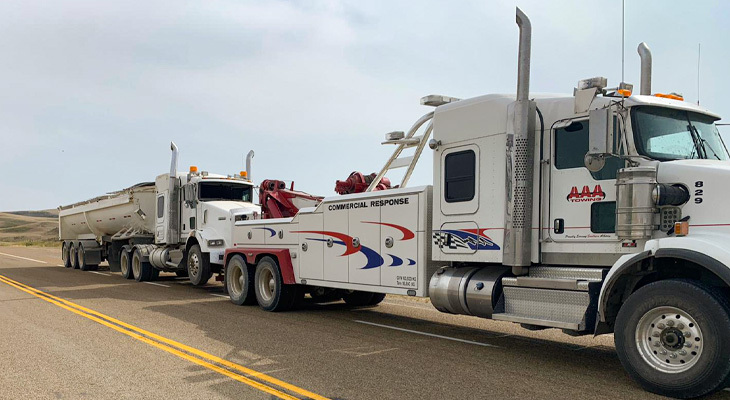 When a commercial truck breaks down, every minute off the road can cost businesses thousands in lost revenue, missed deadlines, and logistical chaos. Whether you operate a single heavy-duty vehicle or manage an entire fleet, breakdowns are inevitable. What sets resilient companies apart is how quickly and efficiently they bounce back.Minimizing downtime isn’t just about calling the nearest towing company. It requires proactive planning, strong partnerships, and clear protocols. In this blog, we’ll break down everything you need to know to reduce downtime after a truck breakdown and keep your operations on track, even in the worst scenarios.
When a commercial truck breaks down, every minute off the road can cost businesses thousands in lost revenue, missed deadlines, and logistical chaos. Whether you operate a single heavy-duty vehicle or manage an entire fleet, breakdowns are inevitable. What sets resilient companies apart is how quickly and efficiently they bounce back.Minimizing downtime isn’t just about calling the nearest towing company. It requires proactive planning, strong partnerships, and clear protocols. In this blog, we’ll break down everything you need to know to reduce downtime after a truck breakdown and keep your operations on track, even in the worst scenarios.
The True Cost Of Truck Downtime
Downtime is more than a temporary inconvenience. According to the American Transportation Research Institute, unscheduled truck repairs and delays can cost between $400 to $700 per day, per vehicle. For time-sensitive industries like freight, construction, or oil and gas, the consequences of prolonged downtime include:- Missed delivery windows and penalty fees
- Contract breaches and client dissatisfaction
- Increased wear on other fleet vehicles
- Reduced driver productivity and morale
- Loss of revenue and potential clients
- To protect your business from these ripple effects, having a downtime reduction strategy is critical.
Step 1: Partner With A Reliable Heavy-Duty Towing Company
One of the most impactful decisions you can make is choosing the right towing company. Not all towing providers offer the same level of service, especially for large vehicles like semis, dump trucks, or flatbeds.Look for a towing partner that offers:- 24/7 heavy-duty towing services
- Fast response times across Calgary and surrounding highways
- Equipment capable of handling commercial and industrial vehicles
- Load transfer and secure storage options
- Certified operators trained in complex recovery scenarios
Step 2: Use A Fleet Management System With Real-Time Monitoring
Modern fleet telematics can alert you to mechanical issues before they become roadside emergencies. GPS tracking, engine diagnostics, and driver behaviour reports can help you:- Spot performance issues early
- Guide drivers to safe pull-over areas during a breakdown
- Share the exact location and details with your towing provider
- Track response and recovery time
Step 3: Implement A Breakdown Response Protocol
A defined internal process helps your drivers and dispatch team respond to breakdowns calmly and efficiently. Your protocol should include:- Driver safety instructions: Pull over safely, engage hazard lights, and stay inside unless unsafe.
- Communication steps: Who to call first, the fleet manager, the dispatcher, or the towing company.
- Information gathering: Vehicle type, cargo, location, issue description.
- Towing partner contact: Have your towing service number stored in both physical form (in the truck) and digital form (apps or driver phones).
- Documentation: Photos of the scene, cargo conditions, and any damage.
Step 4: Choose Towing Services That Offer Load Transfer And Storage
One of the most common causes of extended downtime is when a broken-down vehicle is stuck with an active cargo load. Waiting for another truck or offloading in unsafe conditions wastes valuable hours.Partner with a towing provider that also offers:- Load transfer services for overweight or unbalanced cargo
- Secure storage yards for overnight or long-term vehicle holding
- Accident scene management to recover cargo after a collision
Step 5: Schedule Preventive Maintenance And Inspections
Prevention is always cheaper than recovery. Build a proactive maintenance schedule that includes:- Regular oil changes and fluid checks
- Brake system and tire inspections
- CVIP inspections for Alberta compliance
- Driver walkarounds with pre-trip and post-trip inspections
Step 6: Educate Your Drivers On Emergency Protocols
Even with the best support network in place, your drivers are the first responders to a breakdown. They should be trained on:- Recognizing warning signs like overheating, brake failure, or steering issues
- Knowing when to pull over and request assistance
- What details to provide when contacting the nearest towing company
- Handling cargo during extended delays
Step 7: Keep Communication Open Between Dispatch, Drivers, and Recovery Teams
When a breakdown occurs, fast and accurate communication is essential. Use a centralized dispatch system to:- Track tow truck location and ETA
- Keep clients updated on delivery delays
- Coordinate repairs or temporary vehicle replacements
- Ensure drivers are safe and have transport if their vehicle can’t be recovered quickly
About Us
At AAA Towing, we’ve been providing professional towing services across Calgary and Alberta for over 40 years. Specializing in heavy-duty towing, accident recovery, equipment transport, and load transfer, our team is trusted by fleets, municipalities, and commercial operators alike.With 24/7 dispatch, state-of-the-art equipment, and a full suite of recovery and transport solutions, we help businesses get back on the road faster, with less stress and no delays. Need fast, expert support? Contact us today and experience the AAA difference.Fast & Reliable Towing
We make sure each customer is completely satisfied before we leave the job.